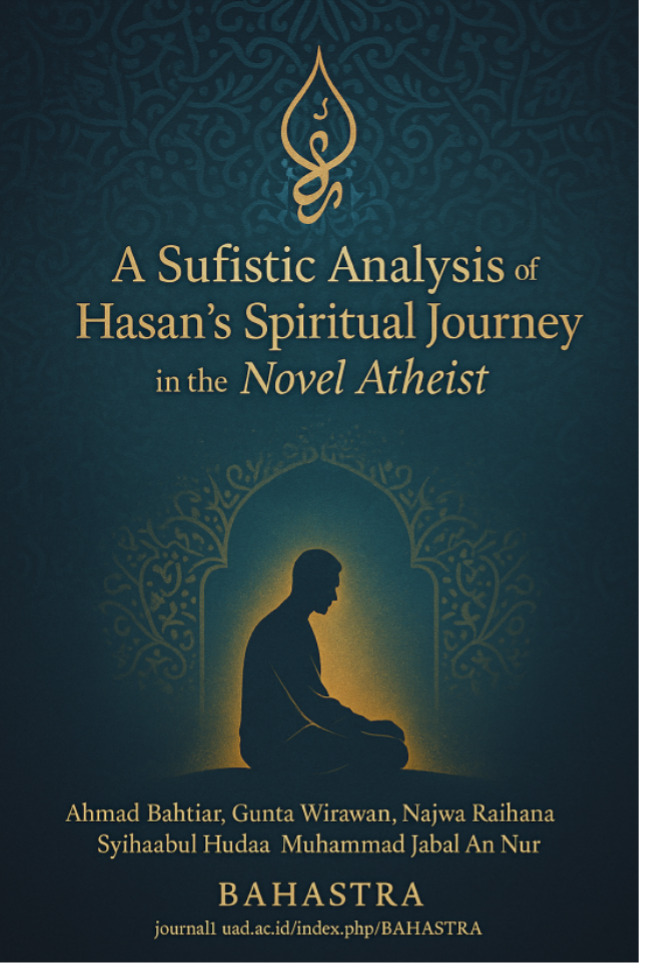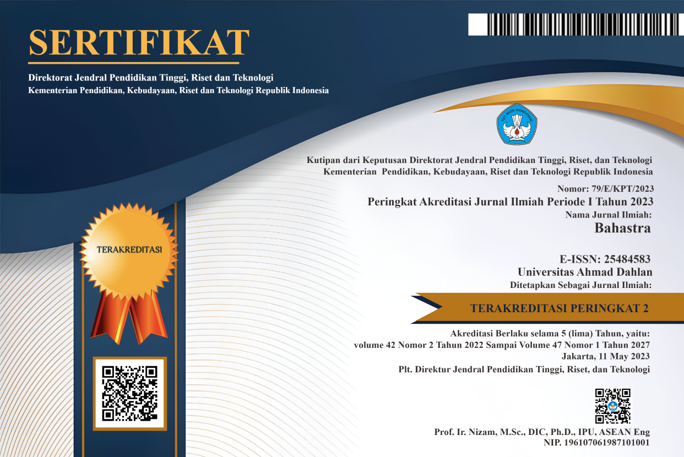A Sufistic Analysis of Hasan's Spiritual Journey in the Novel Atheist
DOI:
https://doi.org/10.26555/bs.v45i2.1587Keywords:
Atheist Novel, Psychology of Literature, SufisticAbstract
Atheis is a novel by Achdiat K. Mihardja published by Balai Pustaka in 1949. There are many studies on this novel. This proves that the novel Atheis is interesting and important to study. This research is a qualitative research using Sigmund Freud's psychoanalysis approach which emphasizes the important role of the unconscious mind in shaping human behavior and experience. The main elements in this theory are motivation, emotion and other aspects of personality. The results show that the novel Atheis contains many religious elements, especially in terms of Sufiistic aspects. In the novel Atheis, the main character, Hasan, experiences an inner debate when he meets his friend, Rusli, who adheres to the ideology of Marxism. As a result, he experiences an inner war between Marxism and Islam. on the other hand, it is depicted that the main character has a strong commitment to religion. Religious commitment is depicted in the story which includes various aspects, ranging from aspects of belief, aspects of practice, aspects of knowledge, aspects of experience, and aspects of consequences. Based on the five aspects, the knowledge aspect is the aspect that appears most often because it is owned and mastered by the characters.
References
Alawiyah, T. (2019). Atheism as a result of the depravity of reality. OSFHome. https://doi. Org/10.17605/OSF. IO/358QU
Amelysa, U., & Ariska, W. (2020). Novel and novelette. Guepedia.
Arianie, E. Y. (2020). Suhistic aspects in the novel asmaraloka by Danarto. Jurnal Bahasa, Sastra, dan Pembelajarannya, 10(2), 203-218. https://doi.org/10.20527/jbsp.v10i2.9377
Aryana, A., Darwis, M., & Nurhayati, N. (2018). Comparison of language styles in novel atheist by Achdiat Karta Mihardja and novel telegram by Putu Wijaya. Journal Of Cultural Sciences, 6(1), 115-122. https://doi.org/10.34050/jib.v6i1.4350
Bahri, S. (2013). Identihication of hasan's indecision in atheist roman by Achdiat Karta Mihardja. Mabasan, 7(1), 36-46. https://doi.org/10.26499/mab.v7i1.172
Creswell, J.W. (2014). Research design: Qualitative, quantitative, and mixed method approaches. SAGE Publications.
Darmutika, L. A. (2018). The main character's resistance to religion in the novel atheist. Paedagoria, 13(1), 86-91. http://journal.ummat.ac.id/index.php/paedagoria/article/download/184/152
Dewojati, C. (2021). Indonesian popular literature. Books.Google.Com.
Freud, S. (2016). The psychoanalysis of Sigmund Freud (Translated by K. Bertens). PT Gramedia Pustaka Utama.
Hashem, O. (2001). Marxist religion: The origins of atheism & the rejection of capitalism. Nuansa Cendekia Foundation.
Hasim, A., & Aziez, F. (2012). Fiction analysis. Multicreation.
Kahid, N. (2020). Suhism in the dynamics of contemporary muslim society life. Mimbar Agama dan Budaya, 37(1), 27-38. https://doi.org//10.15408/mimbar.v0i0.18232
Kartanegara, M. (2006). Menyelami lubuk tasawuf. Books.Google.Com.
Kaufman, A.S., & Kaufman, N.L. (2005). Essentials of research design and methodology. John Wiley And Sons Inc.
Kholid, A. R. I. (2018). Towards God through tarekat (A study of suhism Thought). YAQZHAN JOURNAL, 4(1), 1-23. https://doi.org/10.24235/jy.v4i1.3187
Kim, H., Sefcik, J. S., & Bradway, C. (2017). Characteristics of qualitative descriptive studies: A systematic review. Research In Nursing & Health. https://doi.org/10.1002/nur.21768
Lubis, I. R. (2018). sucistic values in novels (Semiotic analysis of the novel bulan terbelah di langit Amerika karya Hanum Salsabila Rais). Repository.Umsu.Ac.Id. http://Repository.Umsu.Ac.Id/Handle/123456789/10613
Merry, G. (2021). The clow of the novel. Education Magazine.
Mihardja, A. K. (2010). Atheist. Pusat Bahasa.
Moleong. 2000. Qualitative research methodology. PT. Remaja Roesdakarya.
Mulyani, D. S. (2023). Application of suhistic values in the novel rembulan tenggelam di wajahmu. Journal Of Religious Research, 3(1), 50-67. https://doi.org/10.15575/jra.v3i1.19543
Mutmainah, S. (2019). Suhism in the novel khidir by Wiwid Prasetyo and its relevance to character education. FKIP E-PROCEEDING. https://Jurnal.Unej.Ac.Id/Index.Php/Fkip-Epro/Article/View/11974
Pratami, F., & Munaris, M. (2016). Religious commitment in atheist Achdiat K. Mihardja and its learning design for senior high school. Journal Of Kata. http://Jurnal.Fkip.Unila.Ac.Id/Index.Php/BINDO1/Article/Viewhile/10809/7514
Rahayu, E. S. (2020). Perfect Islam in the concept of sharia, tariqah, and hakikat. Emanation: Journal Of Islamic And Social Sciences, 3(1), 1-8. https://doi.org/10.55373/mjchem.v23i2.1008
Rahmawati, R. (2014). Tarekat and its development. Al-Munzir, 7(1), 83-97. https://Ejournal.Iainkendari.Ac.Id/Al-Munzir/Article/View/271/261
Ratna, N.K. 2012. Theories, methods, and techniques of literary research. Student Library.
Saktiono, H. S., Waluyo, H. J., & Hastuti, S. (2018). Atheist novel By Achdiat Karta Mihardja as literature learning material: analysis of literary psychology and educational value. BASASTRA, 6(1), 145-154. https://Jurnal.Fkip.Uns.Ac.Id/Index.Php/Bhs_Indonesia/Article/View/12230
Salamah, S. S. N. (2021). Getting to know indonesian literature. Bintang Pustaka Madani.
Sari, B. K., & Munaris, M. (2017). The journey of faith of Hasan's character in Achiadat K. Mihardja's atheist novel and its implications. Journal Of Kata, 1-12. Http://Jurnal.Fkip.Unila.Ac.Id/Index.Php/BINDO1/Article/Download/12797/9141
Sipahutar, R. A. A. (2020). The role of the teacher syekh ibrahim dalimunthe annaqsyahbandi in teaching the art of annaqsyahbandiyah in Gunung Village Selamat Kabupaten Labuhan Batu [Thesis, UNIMED]. http://Digilib.Unimed.Ac.Id/Id/Eprint/41653
Solihan, B. Q. B. (2016). the psychological conclict of Hasan's character in the novel atheist by Achadiat Karta Mihardja: Sigmund Freud's psychoanalysis study. Eprints.Unram.Ac.Id. http://Eprints.Unram.Ac.Id/Id/Eprint/3345
Suhita, S., & Purwahida, R. (2018). Indonesian literature appreciation and learning. Teenage Rosdakarya.
Suprapto, L., Andayani, A., & Waluyo, B. (2014). Study of literary psychology and character values of novel 9 of nadira by Leila S. Chudori. BASASTRA, 2(3), 1-15. https://www.neliti.com/publications/53934
Tedy, A. (2018). Tarekat mu'tabaroh in Indonesia (Study of tarekat shiddiqiyyah and its teachings). El-Ackar: Journal Of Islamic Thought And Hadith Interpretation, 6(1), 1-17. https://doi.org// 10.29300/JPKTH.V1I6.1224
Teeuw, A. (1984). Literature and literary science: An introduction to literary theory. Pustaka Jaya.
Udayana, H., & Indiatmoko, B. (2017). The expression of love and religious imagery in the novel atheis by Achdiat Karta Mihardja. Seloka, 6(2), 218-225. https://journal.unnes.ac.id/sju/seloka/article/view/17289/8735
Usman, M. I. (2015). Suhism and neo-suhism in the vortex of muslim scholars. Tahdis: Journal Of Al-Hadith Studies, 6(2), 20-42. https://doi.org/10.24252/tahdis.v6i2.7173
Widodo, W., & Dermawan, R. N. (2018). Suhistic subjects in the novel bekisar merah by Ahmad Tohari: A semiotic approach. Caraka, 4(2). https://doi.org/10.30738/caraka.v4i2.2848
Yudiono, K. S. (2010). Introduction to the history of Indonesian literature. Books.Google.Com.
Yulianto, A. (2019). Pertarungan ideologi dalam novel atheis karya Achdiat Karta Mihardja (Ideological conhlict in atheis novel by Achdiat Karta Mihardja). Kandai, 15(1), 117-132. https://doi.org/10.26499/jk.v15i1.1270
Yunita, V., Asri, Y., & Afnita, A. (2012). Postcolonial elements in atheist novel by Achdiat K. Mihardja. JPBSI: Jurnal Pendidikan Bahasa dan Sastra Indonesia, 1(1), 71-78. https://ejournal.unp.ac.id/index.php/pbs/article/view/201
Yusub, F. H. (2017). Interconnection of classical and contemporary suhism (Recognizing Islamic suhism). FIKROTUNA. http://Ejournal.Kopertais4.Or.Id/Madura/Index.Php/Fikrotuna/Article/View/2946
Zubaedi, M. A. (2015). Character education design. Books.Google.Com.

Downloads
Published
Issue
Section
License
Copyright (c) 2025 Ahmad Bahtiar, Gunta Wirawan, Najwa Raihana , Syihaabul Hudaa; Muhammad Jabal An Nur

This work is licensed under a Creative Commons Attribution-ShareAlike 4.0 International License.

1.jpg)






